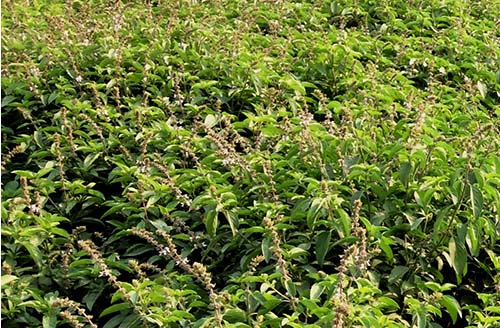CIM-Saumya, CIM-Jyoti CIM Sharada, CIM Suribhi, CIM Snigdha, CIM Ayu, CIM Angana.
CIM-Saumya (CSIR-CIMAP)
CIM-Jyoti (CSIR-CIMAP)
Ocimum (Tulsi), popularly known as Basil, is native to Indian subcontinent and is cultivated throughout Southeast Asian tropics. The plant contains mainly phenols, aldehydes, tannins, saponin and fats. The essential oil major components vary with the species being cultivated and generally essential oil of ocimum are rich in methyl chavicol, linalool, eugenol etc. Ocimum is an important aromatic and medicinal plant which yields various kinds of essential oils and aroma chemicals and find diverse uses in perfumery, cosmetic industries, aromatherapy and also in indigenous systems of medicine. The crop yields about 200 quintals/ha of biomass yielding about 100 kg/ha of essential oil. The crop takes about 60-70 days to mature and, therefore, can be taken as rain-fed crop during monsoon.
Tulsi can be grown in wide variety of climates. It grows as a perennial in tropical climates, and is planted as an annual in temperate regions, where it may be sown directly from seed or transplanted. Tropical, sub tropical and rainy season with 22-28°C and humidity of 75-80 is best for its cultivation. While other members of the basil family (Lamacaea) grow well under competitive circumstances, tulsi prefers little competition for sun and water. As it is a highly frost sensitive plant, it must be protected against temperatures close to freezing point. Basil prefers to be grown in full sun, however will grow (albeit with less vigor) in partial shade as well. To avoid “damping off” disease, it should not be overwatered. The crop growth can be adversely affected in areas which experience heavy and continuous rainfall. It requires moderate annual rainfall with humid conditions for better yield. In colder climates and in winter, basil may be productively cultivated indoors in pots.
Basil is a hardy plant and can be grown on wide range of soils. However a well drained, reasonably fertile soil is ideal for its cultivation. Basils are susceptible to frost and cold-temperature injury. Also, clayey soils and waterlogged areas are unsuitable for the cultivation of the plant. They require full sun and well-drained soils so that they will grow healthy and vigorous. Prepare soils well in advance. Remove all weeds that may compete with the soil nutrients. The land or main field should be ploughed 2 or 3 times with local/country plough or tractor to bring the soil to fine tilth. Make a good internal drainage system in the soil to avoid any water logging. Basils can tolerate slightly acidic soils whereas highly alkaline and saline soils should be avoided. If the pH is lower than 6.5, add a dressing of lime when preparing the soil.
Basil can be propagated through seeds or cuttings.
The seed requirement through nursery is 500 gm seed/ha. The nursery may be raised 25-30 days before transplanting at a spacing of 45 x 30 cm which should be done in the months of June and July.
After trans/ planting proper gapfilling should be done properly. After gapfilling irrigatiae is essential.
10-15 ton well decomposed manure or 5 ton vermi-compost, 40:40 kg phosphorus and potash applied in last ploughing, 80 kg nitrogen applied in 3 parts at regular interval of 20 days.
First irrigation is applied immediately after planting and based on the rainfall and soil moisture, subsequent irrigations should be provided as and when required. Irrigation is not required in rainy season. Make sure the water drains well in rainy season.
In basil farming, 2 weedings are fair enough to control the weeds as these plants become bushy. One hoeing after two months of planting is fair enough. First weeding should be carried out @ 1 month after planting. Second weeding should be carried out @ 2 months after planting. After each harvest, carry out the weeding task to avoid any weed growth.
Major pest found in Tulsi cultivation is "Leaf Rollers" and common diseases found are Powdery mildew, root-rot and seedling blight. To prevent these pests and diseases, following control downy mildew measures should be taken:-
Tulsi crop will be ready for first harvest after three months of planting. This crop should be harvested when plants are in full bloom. Cut the plants at least 15 cm above the fround level to ensure good regeneration for future harvests. After first harvest, next one can be carried out after 70 to 75 days interval. Cutting these plants on sunny days are preferred to obtain good yield and oil content.
The herb yield turned out to be 200-250 q/ha, whereas the oil yield was 100-125 kg/ha.
Cost of cultivation : Rs. 20,000/ha
Gross return : Rs. 60,000/ha
Net profit : Rs. 40,000/ha
Cultivation under unirrigated condition as possiblewith half return with componsion to irrigated.
By seeds or cuttings
U.P.,Bihar, M.P., Utranchal, Punjab etc.



